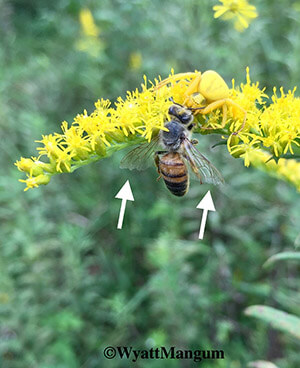Bees & Beekeeping: Present & Past
Bees & Beekeeping: Past & Present – April 2024 The Dangerous Lives of Foraging Bees: Part 2

In Part 1 of this series, we ended with bees becoming ensnared in spider webs. We continue with watching bees forage.
I spend a considerable amount of time studying bees, especially in the summer. Watching bees forage, chasing them from flower to flower, camera in hand, filming and feeling for when the camera begins to overheat, one learns a constellation of fine details not readily described in the literature.
Repeatedly landing at dozens of flowers on a foraging trip exposes a bee to an incredible amount of peril. Sure, a bee is armed with a stinger. However, predators in hiding have evolved defenses against stinging. Any abnormal bee movement on the flowers, or a bee standing in an odd position, all signal something is wrong, which could be due to a predator.
Figure 1 shows a bee on goldenrod, apparently resting. Sometimes a bee will discard pollen from a similar hanging position (or from an edge of a leaf). When discarding pollen, a bee essentially grooms herself and lets the pollen grains fall away, instead of packing them in her corbiculae (pollen baskets). Bees groom off unwanted pollen after it accumulates on them from nectar foraging. I see pollen discarding with large-size pollen grains, typically cotton, squash and Opuntia (cactus flowers). Pollen-grain size is not a complete explanation for pollen discarding. In my area, a bee discarding pollen from goldenrod is not very likely, but the bee’s hanging position is similar.
Let’s look at Figure 1 in a different way, as a thermal image. I used a thermal camera for Figure 2, even though on a sunny or partly cloudy day the background heat can clutter a thermal image. The small blurry red region is the heat signature from the crab spider, which had ambushed the bee (grabbing the bee from the head). The spider is directly above the bee. In the previous photograph, the spider had shifted a little to the right. Here is another method of spider predation on bees, not by webs, but rather by stealth and ambush. Flowers mean life to bees –– and sometimes death, a truth whose opposite also can be true.
Consider a more exotic flower, which fascinated me the moment I saw my first one. This flower is in the genus Passiflora, shown… (end of excerpt)


